2016年英语译林牛津版必修二 Unit 1 Tales of the unexplained Task 课件(共45张PPT)
文档属性
| 名称 | 2016年英语译林牛津版必修二 Unit 1 Tales of the unexplained Task 课件(共45张PPT) | 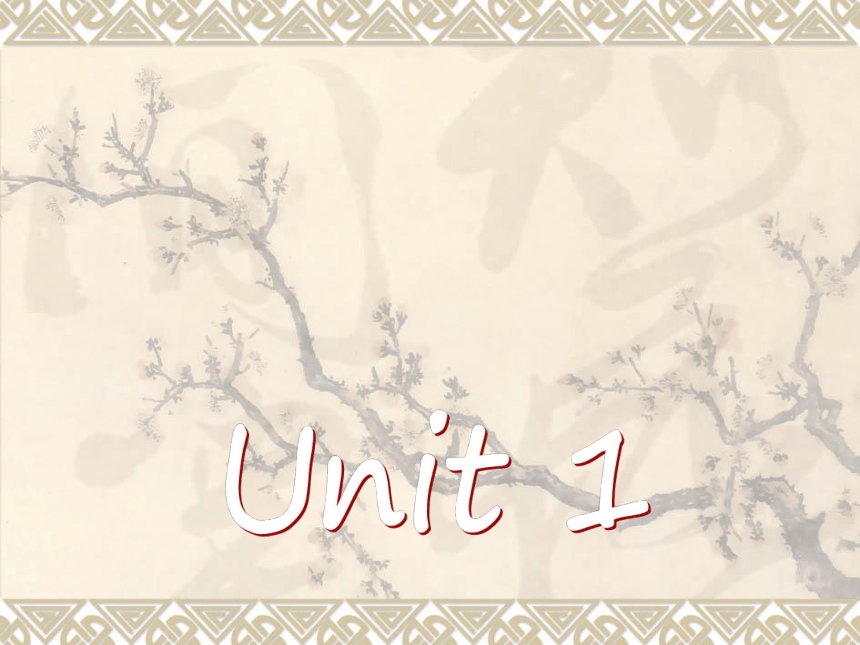 | |
| 格式 | zip | ||
| 文件大小 | 734.6KB | ||
| 资源类型 | 教案 | ||
| 版本资源 | 牛津译林版 | ||
| 科目 | 英语 | ||
| 更新时间 | 2015-12-27 09:35:24 | ||
图片预览

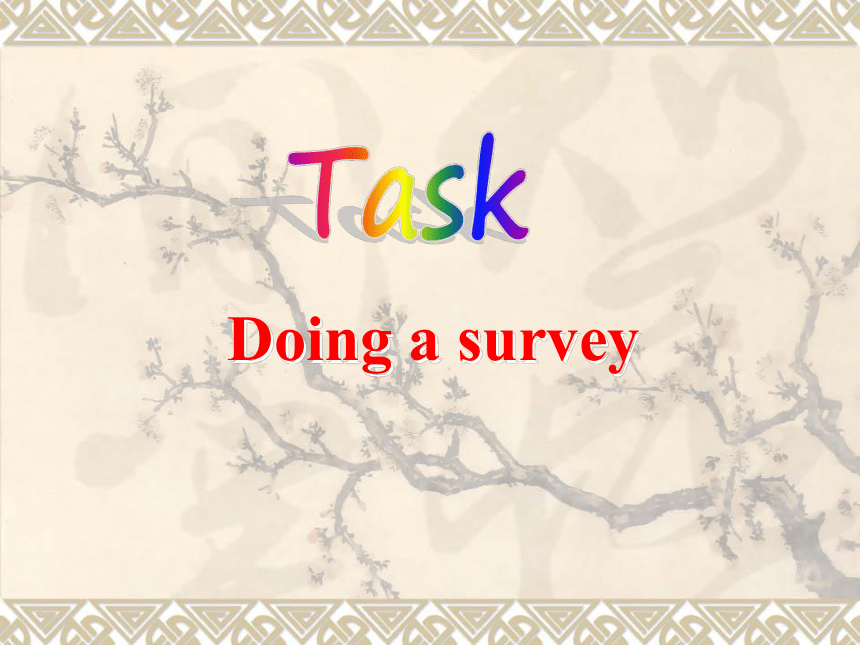
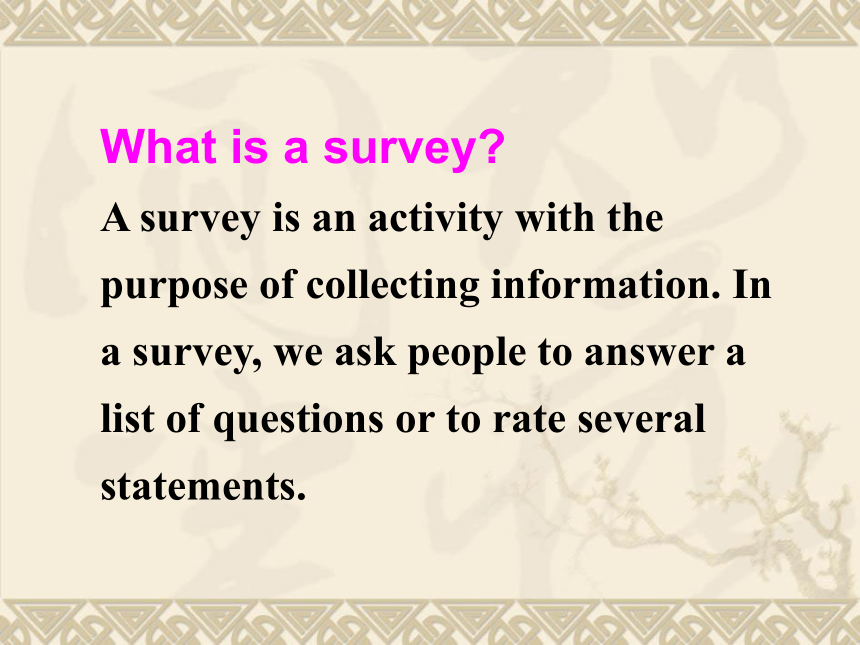
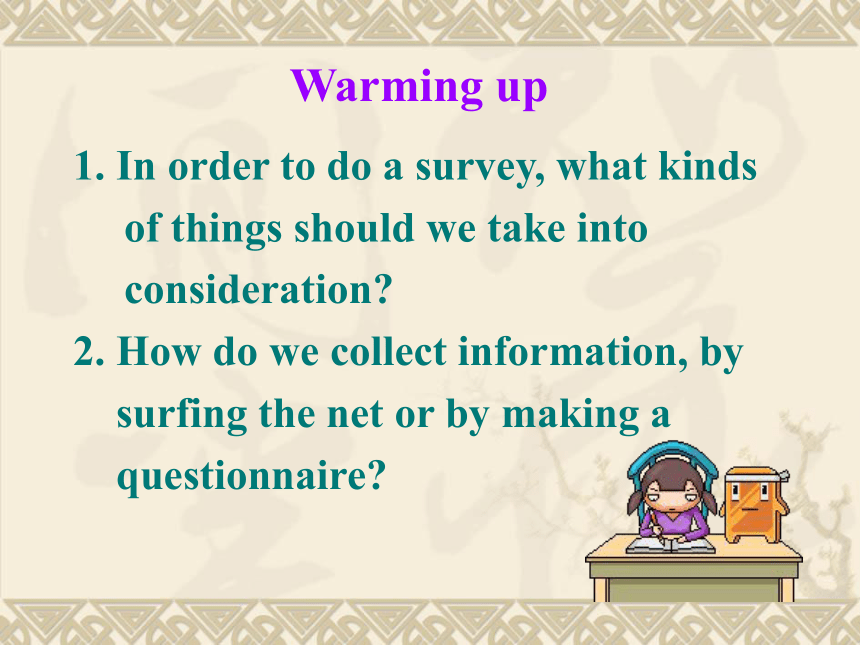
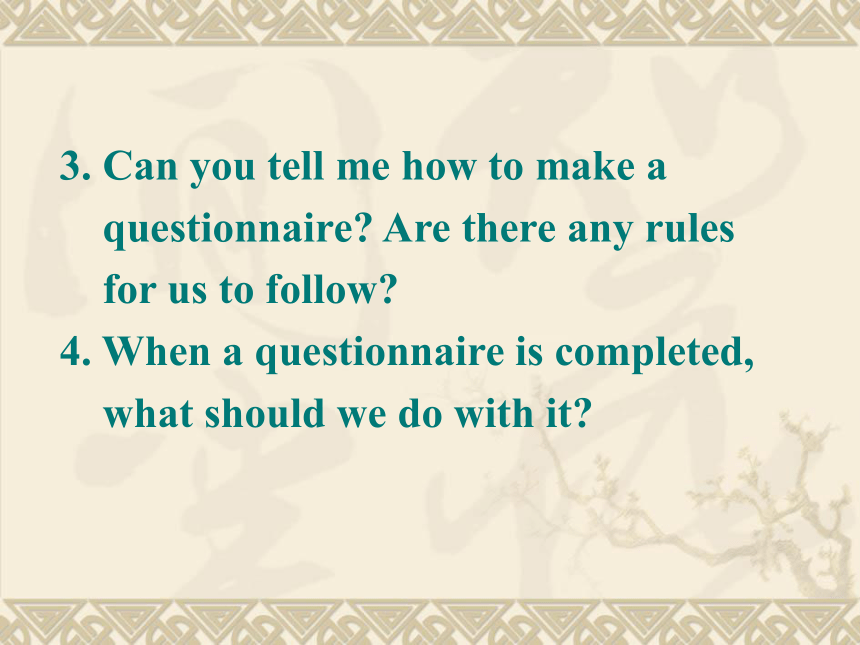
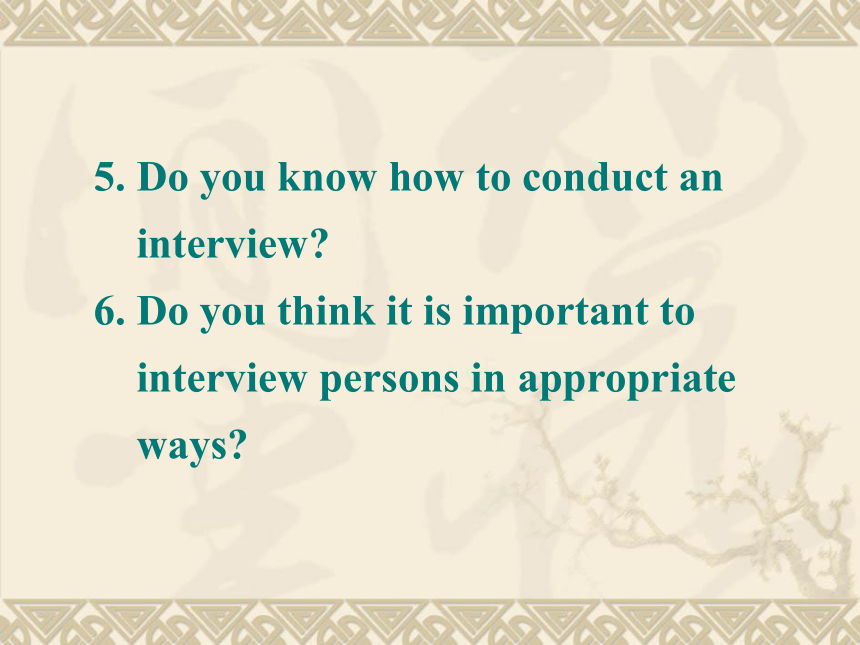
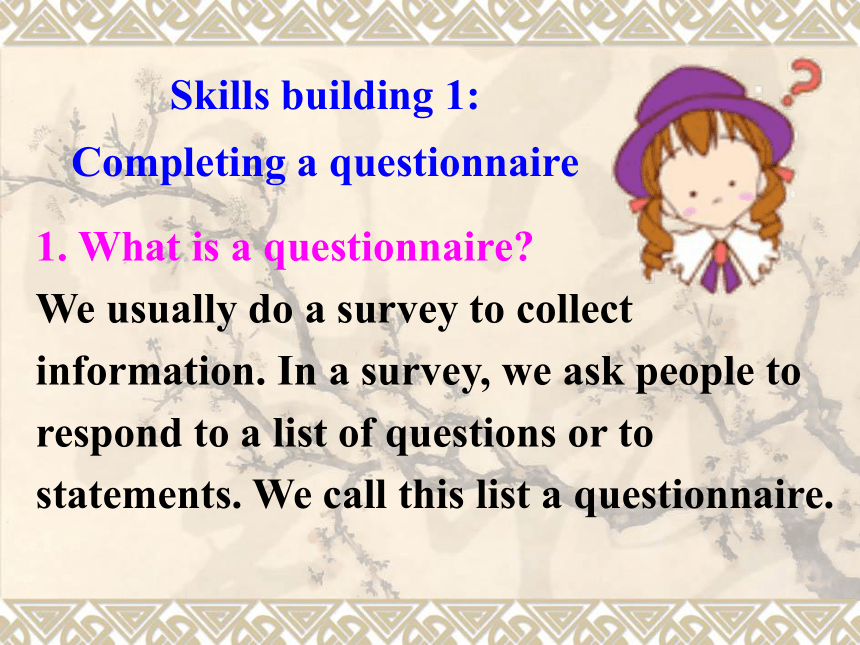
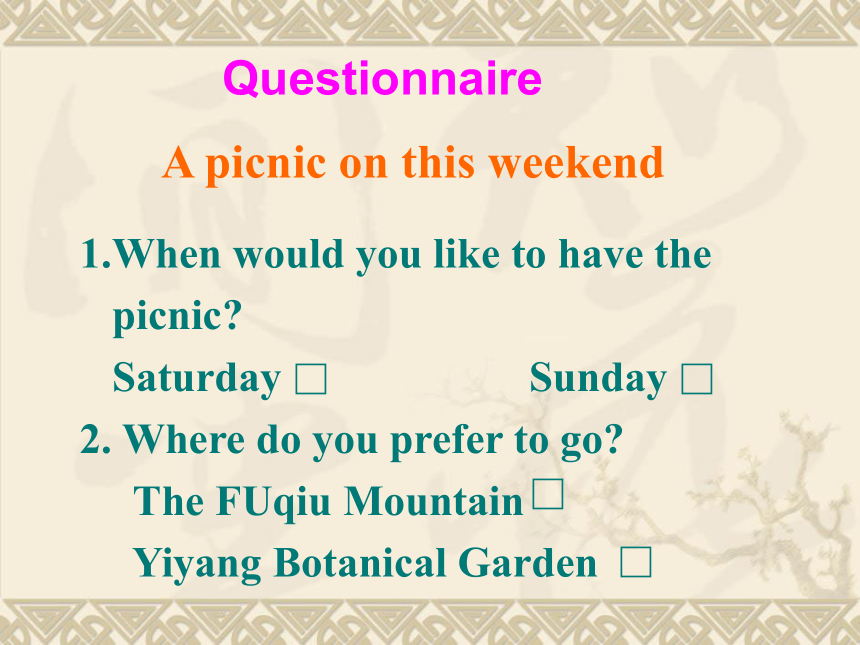
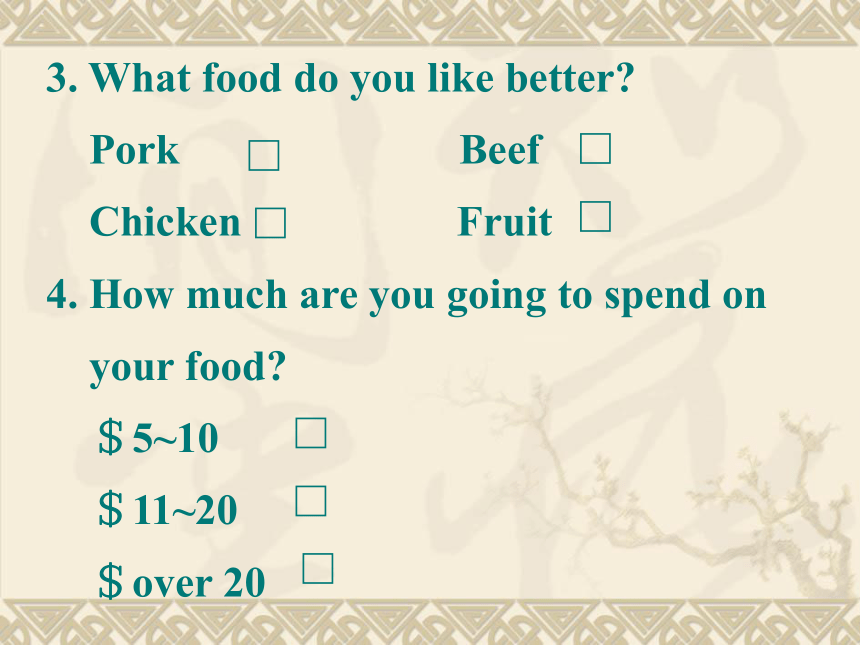
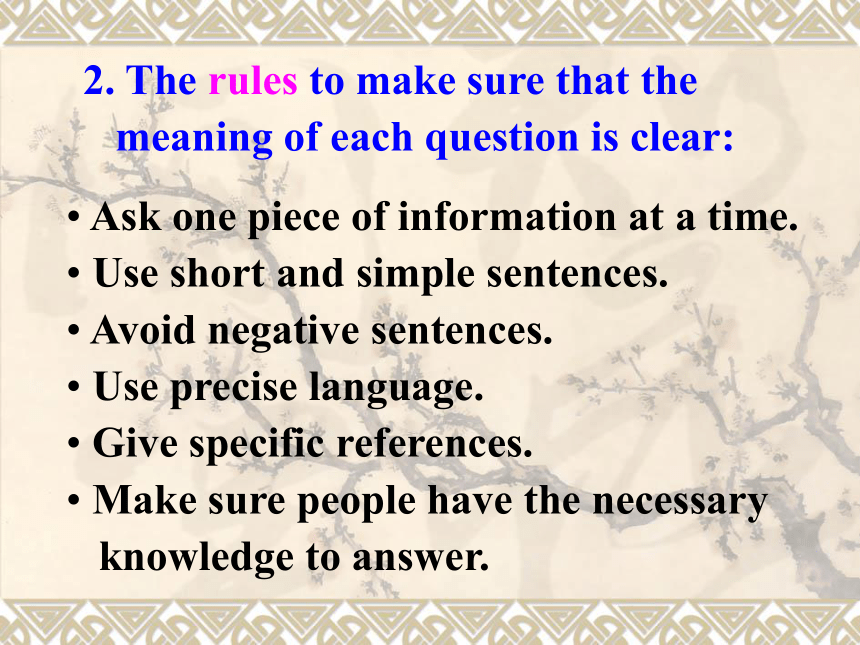
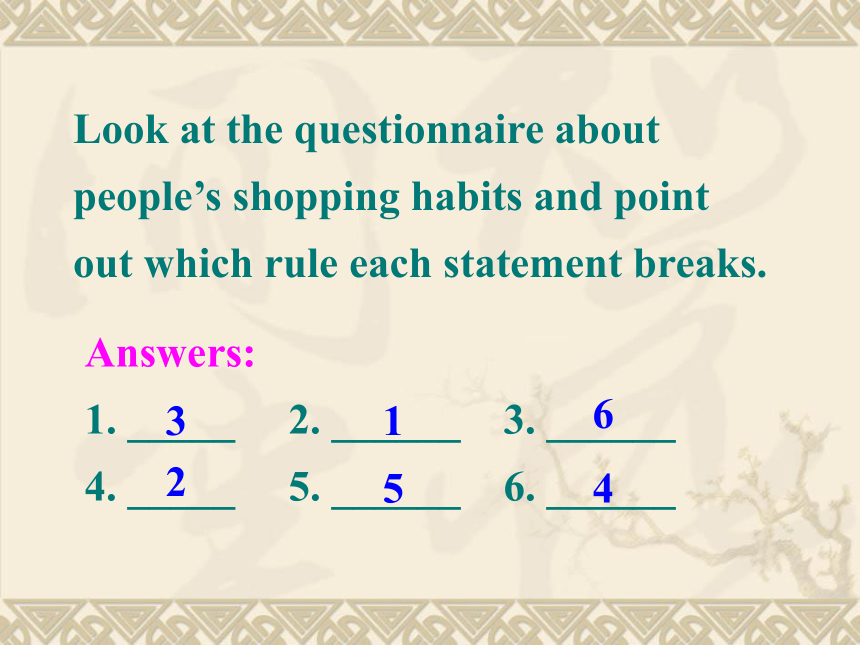
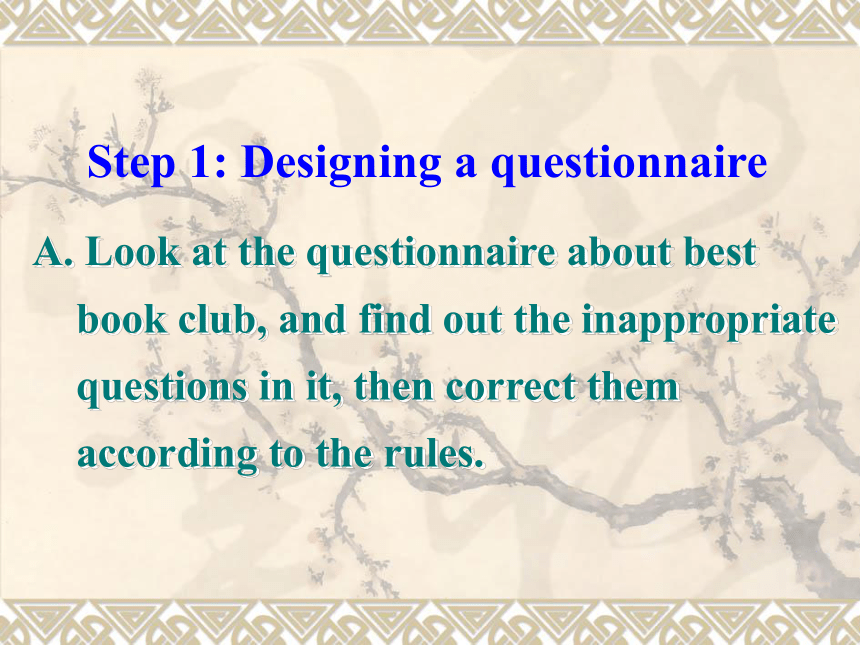
文档简介
课件45张PPT。Unit 1Doing a surveyTask What is a survey?
A survey is an activity with the purpose of collecting information. In a survey, we ask people to answer a list of questions or to rate several statements.Warming up1. In order to do a survey, what kinds of things should we take into consideration?
2. How do we collect information, by
surfing the net or by making a
questionnaire?3. Can you tell me how to make a
questionnaire? Are there any rules
for us to follow?
4. When a questionnaire is completed,
what should we do with it?5. Do you know how to conduct an
interview?
6. Do you think it is important to
interview persons in appropriate
ways?Skills building 1:
Completing a questionnaire1. What is a questionnaire?
We usually do a survey to collect information. In a survey, we ask people to respond to a list of questions or to statements. We call this list a questionnaire.Questionnaire A picnic on this weekend When would you like to have the picnic?
Saturday Sunday
2. Where do you prefer to go?
The FUqiu Mountain
Yiyang Botanical Garden□□□□3. What food do you like better?
Pork Beef
Chicken Fruit
4. How much are you going to spend on
your food?
$5~10
$11~20
$over 20 □□□□□□□ Ask one piece of information at a time.
Use short and simple sentences.
Avoid negative sentences.
Use precise language.
Give specific references.
Make sure people have the necessary
knowledge to answer. 2. The rules to make sure that the
meaning of each question is clear:Answers:
1. _____ 2. ______ 3. ______
4. _____ 5. ______ 6. ______Look at the questionnaire about
people’s shopping habits and point
out which rule each statement breaks.231654A. Look at the questionnaire about best book club, and find out the inappropriate questions in it, then correct them according to the rules.Step 1: Designing a questionnaireAnswers:
1. Question 2 should be split into two questions:
a. How did you find out about Best Book
Club?
b. When did you join the club?2. Question 3 should be made more specific by adding the words ‘in the last six’ .
3. The explanation in brackets for Question 6 should be simplified as the following: (Please write down your answer.) .Listening Listen to an interview with a Best Club member, and fill in your corrected questionnaire.1. How old are you?
below 15 □ 15-20 □ over 20 □
2. How did you find out about the Best Book Club?
newspaper □ magazines□
friends □ Internet □Answers3. When did you join the club?
this year □ last year □
the year before last □
4. How many times have you visited bookshops in the last six months?
0 □ 1-5□ 6-10 □ over 10□5. How much have you spent on books in the last six months?
¥0- ¥ 50 □ ¥51- ¥ 100 □
over ¥100 □6. What subject are you most interested in?
humour □ travel□ history □
sports □ science □
other( Please write down your answers.)
__________________________________7. Why did you join the Best Book Club?
for new books □ for discounts □
for used book □ for free books □
for book exchange □
other( Please write down your answers.)
________________________________1. How do you greet each other or your teachers on the way to school in the morning?
2. Is there any differences between greeting your friends and greeting a stranger?Skills building 2:
Greeting others and making introductions 1. Greeting someone formally, we can use:
Good morning / afternoon.
Nice to meet you.
2. Greeting a friend or classmate, we use:
Hello! / Hi! / Hey!
3. Greeting a stranger, we can use:
Good morning / afternoon.
Excuse me, sir / madam. Hello.What will you do after greeting a stranger?
We can introduce ourselves and tell the
person what we want to do and why.Excuse me, sir. I am Sanha. I’d like to ask you a few questions if you don’t mind.Here are some common introductions: I’m…from…. I’d like to ask you a few questions about your opinions/
programme/ new book.
My name is… I’m from … I’d like to ask you a few questions if you don’t mind. It’s for… Read the example conversation and then make up a conversation using what you have learnt in this part. One of you should be a reporter from the school magazine, the other should be a student who took part in a school festival.Work in pairs.Step 2: carrying out an interviewWork in pairs. Find a partner to interview. Take turns to be the interviewer and the club member. Remember to greet one another appropriately. sum upConducting a surveyDesigning a questionnaireConducting an interviewGreeting Introduce yourself …Thanks Hello.Hello.You can use the vocabulary on page 15.
You can begin like this:My name is Amy. I am a staff member in this club. I know you’re a member of our club. Would you mind if I ask you some questions?Of course not.Work in pairs and one act as the boss of
the club, the other the employee of the
club. You may use the questions in Part B.Skills building 3: Analyzing statisticsWhat’s the purpose of analyzing statistics?1. Analyzing statistics to draw conclusions.
2. Analyzing statistics to make suggestions. Read the chart about students’ hobbies
and interests, then analyse the statistics.
Try to draw at least three more
conclusions and make another three
suggestions.Have a try!Surfing
the InternetDancingConclusions:
1. Doing sport is the most popular activity for students in the school.
2.________________________________
________________________________.
3.________________________________.
4.________________________________.Only a few students like readingMost students do not like dancingSuggestions:
1. The school should have more sports equipment.
2.________________________________
_________________________________
_________________________________.3._________________________________
________________________________.
4._________________________________
_________________________________
_________________________________.The school should find ways to get thestudents interested in readingSchool social events should not include dancing, because most students simply not interested in it.Step 3: writing a reportLook at the chart in part A on page 17 and analyse the statistics. Work in pairs to discuss the statistics, then try to make some suggestions based on the conclusions. Read the report, compare the suggestions in the report with the suggestions you discussed and decide whose suggestions are better and more practical.Read the directions of Part B and discuss
how to write the report with your
partners.Possible example:
From our recent survey of students, we
have found that only 8 per cent of the
students like reading. The most popular
reading subject is humour, which 28 per
cent of the students enjoy. This is closely
followed by travel books, which 25 per
cent of the students are interested in.16 per cent of the students like reading
about sports and 12 per cent like science
books. A small number of the students
like other subjects, such as history.
We want to get the students interested in
reading. For this reason, we suggest that
we have a humour book club, since
humour is the most popular subject.Each class would have its own club
meetings once a week. At the meetings,
they would discuss what books they are
currently reading, and could even read
aloud some funny bits from the books.
The class monitors could then come up
with a list of humour books which are popular with the students, and this list could be shared with the other classes. This would be a good way to encourage students to read by helping them learn about books that they might enjoy. Finish the workbook exercise.
Preview the Project part.HomeworkThank you for listening!
A survey is an activity with the purpose of collecting information. In a survey, we ask people to answer a list of questions or to rate several statements.Warming up1. In order to do a survey, what kinds of things should we take into consideration?
2. How do we collect information, by
surfing the net or by making a
questionnaire?3. Can you tell me how to make a
questionnaire? Are there any rules
for us to follow?
4. When a questionnaire is completed,
what should we do with it?5. Do you know how to conduct an
interview?
6. Do you think it is important to
interview persons in appropriate
ways?Skills building 1:
Completing a questionnaire1. What is a questionnaire?
We usually do a survey to collect information. In a survey, we ask people to respond to a list of questions or to statements. We call this list a questionnaire.Questionnaire A picnic on this weekend When would you like to have the picnic?
Saturday Sunday
2. Where do you prefer to go?
The FUqiu Mountain
Yiyang Botanical Garden□□□□3. What food do you like better?
Pork Beef
Chicken Fruit
4. How much are you going to spend on
your food?
$5~10
$11~20
$over 20 □□□□□□□ Ask one piece of information at a time.
Use short and simple sentences.
Avoid negative sentences.
Use precise language.
Give specific references.
Make sure people have the necessary
knowledge to answer. 2. The rules to make sure that the
meaning of each question is clear:Answers:
1. _____ 2. ______ 3. ______
4. _____ 5. ______ 6. ______Look at the questionnaire about
people’s shopping habits and point
out which rule each statement breaks.231654A. Look at the questionnaire about best book club, and find out the inappropriate questions in it, then correct them according to the rules.Step 1: Designing a questionnaireAnswers:
1. Question 2 should be split into two questions:
a. How did you find out about Best Book
Club?
b. When did you join the club?2. Question 3 should be made more specific by adding the words ‘in the last six’ .
3. The explanation in brackets for Question 6 should be simplified as the following: (Please write down your answer.) .Listening Listen to an interview with a Best Club member, and fill in your corrected questionnaire.1. How old are you?
below 15 □ 15-20 □ over 20 □
2. How did you find out about the Best Book Club?
newspaper □ magazines□
friends □ Internet □Answers3. When did you join the club?
this year □ last year □
the year before last □
4. How many times have you visited bookshops in the last six months?
0 □ 1-5□ 6-10 □ over 10□5. How much have you spent on books in the last six months?
¥0- ¥ 50 □ ¥51- ¥ 100 □
over ¥100 □6. What subject are you most interested in?
humour □ travel□ history □
sports □ science □
other( Please write down your answers.)
__________________________________7. Why did you join the Best Book Club?
for new books □ for discounts □
for used book □ for free books □
for book exchange □
other( Please write down your answers.)
________________________________1. How do you greet each other or your teachers on the way to school in the morning?
2. Is there any differences between greeting your friends and greeting a stranger?Skills building 2:
Greeting others and making introductions 1. Greeting someone formally, we can use:
Good morning / afternoon.
Nice to meet you.
2. Greeting a friend or classmate, we use:
Hello! / Hi! / Hey!
3. Greeting a stranger, we can use:
Good morning / afternoon.
Excuse me, sir / madam. Hello.What will you do after greeting a stranger?
We can introduce ourselves and tell the
person what we want to do and why.Excuse me, sir. I am Sanha. I’d like to ask you a few questions if you don’t mind.Here are some common introductions: I’m…from…. I’d like to ask you a few questions about your opinions/
programme/ new book.
My name is… I’m from … I’d like to ask you a few questions if you don’t mind. It’s for… Read the example conversation and then make up a conversation using what you have learnt in this part. One of you should be a reporter from the school magazine, the other should be a student who took part in a school festival.Work in pairs.Step 2: carrying out an interviewWork in pairs. Find a partner to interview. Take turns to be the interviewer and the club member. Remember to greet one another appropriately. sum upConducting a surveyDesigning a questionnaireConducting an interviewGreeting Introduce yourself …Thanks Hello.Hello.You can use the vocabulary on page 15.
You can begin like this:My name is Amy. I am a staff member in this club. I know you’re a member of our club. Would you mind if I ask you some questions?Of course not.Work in pairs and one act as the boss of
the club, the other the employee of the
club. You may use the questions in Part B.Skills building 3: Analyzing statisticsWhat’s the purpose of analyzing statistics?1. Analyzing statistics to draw conclusions.
2. Analyzing statistics to make suggestions. Read the chart about students’ hobbies
and interests, then analyse the statistics.
Try to draw at least three more
conclusions and make another three
suggestions.Have a try!Surfing
the InternetDancingConclusions:
1. Doing sport is the most popular activity for students in the school.
2.________________________________
________________________________.
3.________________________________.
4.________________________________.Only a few students like readingMost students do not like dancingSuggestions:
1. The school should have more sports equipment.
2.________________________________
_________________________________
_________________________________.3._________________________________
________________________________.
4._________________________________
_________________________________
_________________________________.The school should find ways to get thestudents interested in readingSchool social events should not include dancing, because most students simply not interested in it.Step 3: writing a reportLook at the chart in part A on page 17 and analyse the statistics. Work in pairs to discuss the statistics, then try to make some suggestions based on the conclusions. Read the report, compare the suggestions in the report with the suggestions you discussed and decide whose suggestions are better and more practical.Read the directions of Part B and discuss
how to write the report with your
partners.Possible example:
From our recent survey of students, we
have found that only 8 per cent of the
students like reading. The most popular
reading subject is humour, which 28 per
cent of the students enjoy. This is closely
followed by travel books, which 25 per
cent of the students are interested in.16 per cent of the students like reading
about sports and 12 per cent like science
books. A small number of the students
like other subjects, such as history.
We want to get the students interested in
reading. For this reason, we suggest that
we have a humour book club, since
humour is the most popular subject.Each class would have its own club
meetings once a week. At the meetings,
they would discuss what books they are
currently reading, and could even read
aloud some funny bits from the books.
The class monitors could then come up
with a list of humour books which are popular with the students, and this list could be shared with the other classes. This would be a good way to encourage students to read by helping them learn about books that they might enjoy. Finish the workbook exercise.
Preview the Project part.HomeworkThank you for listening!
